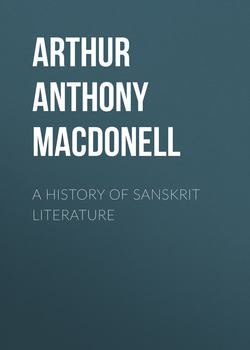A History of Sanskrit Literature

Реклама. ООО «ЛитРес», ИНН: 7719571260.
Оглавление
Arthur Anthony MacDonell. A History of Sanskrit Literature
Preface
Chapter I. Introductory
Chapter II. The Vedic Period
Chapter III. The Rigveda
Chapter IV. Poetry of the Rigveda
Chapter V. Philosophy of the Rigveda
Chapter VI. The Rigvedic Age
Chapter VII. The Later Vedas
Chapter VIII. The Brāhmaṇas
Chapter IX. The Sūtras
Chapter X. The Epics
Chapter XI. Kāvya or Court Epic
Chapter XII. Lyric Poetry (Circa 400–1100 A.D.)
Chapter XIII. The Drama
Chapter XIV. Fairy Tales and Fables
Chapter XV. Philosophy
Chapter XVI. Sanskrit Literature and the West
Appendix on Technical Literature
Bibliographical Notes
Отрывок из книги
Since the Renaissance there has been no event of such world-wide significance in the history of culture as the discovery of Sanskrit literature in the latter part of the eighteenth century. After Alexander’s invasion, the Greeks became to some extent acquainted with the learning of the Indians; the Arabs, in the Middle Ages, introduced the knowledge of Indian science to the West; a few European missionaries, from the sixteenth century onwards, were not only aware of the existence of, but also acquired some familiarity with, the ancient language of India; and Abraham Roger even translated the Sanskrit poet Bhartṛihari into Dutch as early as 1651. Nevertheless, till about a hundred and twenty years ago there was no authentic information in Europe about the existence of Sanskrit literature, but only vague surmise, finding expression in stories about the wisdom of the Indians. The enthusiasm with which Voltaire in his Essai sur les Mœurs et l’Esprit des Nations greeted the lore of the Ezour Vedam, a work brought from India and introduced to his notice in the middle of the last century, was premature. For this work was later proved to be a forgery made in the seventeenth century by a Jesuit missionary. The scepticism justified by this fabrication, and indulged in when the discovery of the genuine Sanskrit literature was announced, survived far into the present century. Thus, Dugald Stewart, the philosopher, wrote an essay in which he endeavoured to prove that not only Sanskrit literature, but also the Sanskrit language, was a forgery made by the crafty Brahmans on the model of Greek after Alexander’s conquest. Indeed, this view was elaborately defended by a professor at Dublin as late as the year 1838.
The first impulse to the study of Sanskrit was given by the practical administrative needs of our Indian possessions. Warren Hastings, at that time Governor-General, clearly seeing the advantage of ruling the Hindus as far as possible according to their own laws and customs, caused a number of Brahmans to prepare a digest based on the best ancient Indian legal authorities. An English version of this Sanskrit compilation, made through the medium of a Persian translation, was published in 1776. The introduction to this work, besides giving specimens of the Sanskrit script, for the first time supplied some trustworthy information about the ancient Indian language and literature. The earliest step, however, towards making Europe acquainted with actual Sanskrit writings was taken by Charles Wilkins, who, having, at the instigation of Warren Hastings, acquired a considerable knowledge of Sanskrit at Benares, published in 1785 a translation of the Bhagavad-gītā, or The Song of the Adorable One, and two years later, a version of the well-known collection of fables entitled Hitopadeça, or Friendly Advice.
.....
Indra naturally became the god of battle, and is more frequently invoked than any other deity as a helper in conflicts with earthly enemies. In the words of one poet, he protects the Aryan colour (varṇa) and subjects the black skin; while another extols him for having dispersed 50,000 of the black race and rent their citadels. His combats are frequently called gavishṭi, “desire of cows,” his gifts being considered the result of victories.
The following stanzas (ii. 12, 2 and 13) will serve as a specimen of the way in which the greatness of Indra is celebrated:—
.....